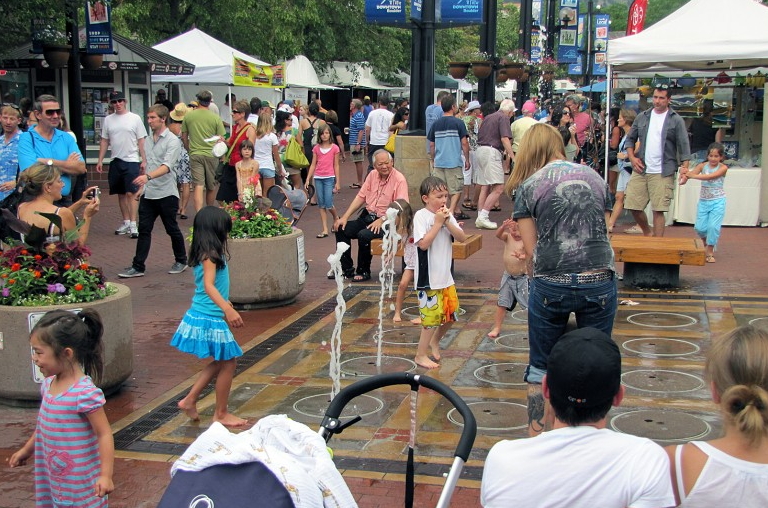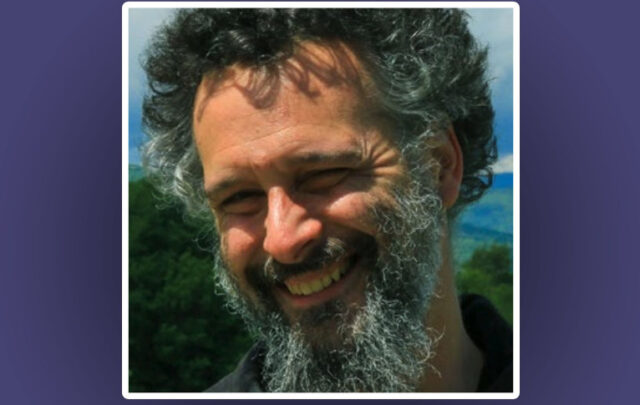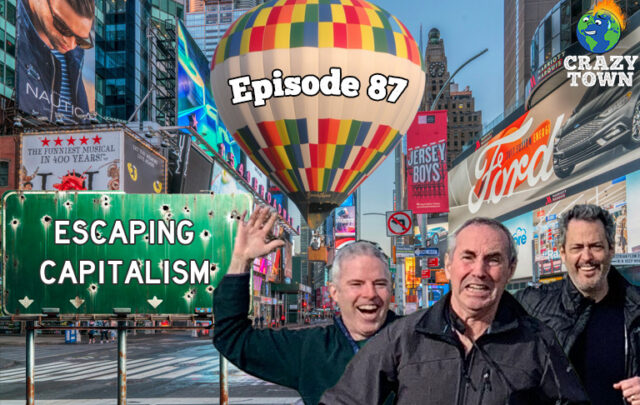Good health means more than good medical care.
Many other things affect how long we live and how healthy we feel—conditions in our housing and neighborhoods, the social and physical environment of our communities, economic opportunities and the levels of stress in our lives.
According to a landmark University of Wisconsin study, the state of our overall health is attributable to four major factors:
- 20 percent—access to and quality of clinical health care
- 40 percent—social and economic factors in our lives
- 30 percent—individual factors and behaviors
- 10 percent—the physical environment in which we live
The good news is that we can improve these factors to boost everyone’s health, no matter where they live. Last year, Kaiser Permanente and Project for Public Spaces released a detailed report of peer-reviewed research making the case that healthy communities foster healthy people.
Addressing these issues is the point of a Centers for Disease Control-funded initiative to improve community health—the National Implementation and Dissemination for Chronic Disease Prevention program, known as Partnering4Health.
As part of the project, the American Planning Association, the Society for Public Health Education (SOPHE), the National WIC Association, Directors of Health Promotion and Education and American Heart Association/American Stroke Association are using community-based solutions to boost health for Americans of all incomes, ethnicities and regions.
They are working to reduce a 21st century epidemic—preventable chronic diseases like diabetes, cardiovascular disease, arthritis and many forms of cancer—by helping communities increase physical activity, nutritious eating, breastfeeding and other healthy ways of living.
Recently more than 200 community leaders from among the 97 communities participating in the program came together in Denver to share best practices and success stories.
“There’s more to health than great medical care,” declared Dr. Eduardo Sanchez, Chief Medical Officer for Prevention of the America Heart Association at the meeting.
A spate of recent medical research shows that your zip code can be a more accurate measure of your prospects for a healthy life than your genetic code. Sanchez pointed out that people living in certain low-income, racially segregated areas of Chicago live 16 years less, on average, than those in affluent city neighborhoods because of disparities in income, employment, social support and education.
More real-world evidence for this place-based approach to health was found in the stories that community health advocates brought to Denver from their hometowns:
Kenosha, Wisconsin
A Prescription for Better Health
Recent medical studies suggest that healthy habits can be as effective as some medicines in reducing and preventing many prevalent diseases. Concerned that Kenosha’s health statistics rank among the lowest in the state, local Haitian-American physician Junith Thompson worked with local public health groups to design RX pads prescribing patients to eat more fresh vegetables, take up new physical activities, set aside daily time for reflection and other positive lifestyle changes. Distributed by the Kenosha Health Improvement Project, they are now used at a number of clinics and health agencies in southeastern Wisconsin.
Plaquemines Parish, Louisiana
Listen to the Music
“In Louisiana, you have to reach people through their culture,” explains Mary Schultheis, project supervisor for Healthy Plaquemines Parish Now. In her community, just outside New Orleans, that means music. So she adapted popular songs into public service announcements that promote breastfeeding. A new recording of the classic Mardi Gras song “Iko Iko,” now trumpets, “Hey, now. Hey, now. Mothers are breastfeeding!” New lyrics to the ‘70s soul tune “Mr. Big Stuff,” shout out: “It’s the right stuff. We’re trying to make healthy babies.” Another thrust of the organization is to connect more people to existing resources for healthier living such as WIC programs, farmers markets, food shelves and faith-based health organizations.
East St. Louis, Illinois
Health on the Corner
Many residents of this predominantly African-American city buy their groceries at corner stores. That’s why Make Health Happen!—a coalition of health, government, business and civic groups—engaged six shop owners to stock more nutritious foods. One store was able to add a cooler for fresh fruits and veggies thanks to a donation from the regional YMCA. Another worked with a local graffiti artist to create a mural showcasing the store’s new selection of healthy offerings. Lowering the cost of healthy foods through coupons accepted at groceries and farmers markets also boosts wholesome eating throughout this city of 27,000.
Loudoun County, Virginia
Water as One Answer to Childhood Obesity
Since many kids swill sugar-laden beverages throughout the day, Loudoun County’s health department introduced “It’s Water Time” to encourage elementary and Head Start students to drink more water instead of juice or sweetened beverages. Captain Hydro, a flying penguin toting a water bottle, extols water as the best thirst-quencher in coloring books and other materials for kids and their parents. Promoting breastfeeding, offering healthier options in vending machines and increasing access to nutritious food are other strategies being used to reduce childhood obesity in this suburban community.
Wichita Falls, Texas
Making WIC Easier to Use
The number of people involved in the Women, Infants and Children (WIC) supplemental nutrition program was falling in Wichita County, Texas, which potentially means a less healthy community. A big part of the problem was confusion among both shoppers and grocery store clerks about what foods were eligible for purchase with the benefits. The county public health office and local WIC office worked together training clerks about the program and distributed handy shopping guides to WIC participants. Transportation was another problem, especially in reaching a local farmers market where special deals were available with WIC coupons. So now fruit and vegetable vendors are also setting up shop at the local WIC office where women enroll and visit for benefits.
Tattnall County, Georgia
A Friendly Place for Breastfeeding
Mommy & Me, Healthy as Can Be is a new program to make breastfeeding easier and more acceptable throughout this rural county. More than 50 local businesses have become breastfeeding friendly locations thanks to a joint effort by the Southeast Health District and the Partner for Health program at Meadows Regional Medical Center. The medical center also works more closely with the area WIC office now.
More Success Stories—from Michigan to Texas
That’s not all. Trailnet is pursuing an ambitious plan to connect St. Louis with a network of safe, comfortable, protected bikeways, which will encourage people of all ages, incomes and physical shapes to bike around the city. Tarrant County WIC in Fort Worth sponsors a breastfeeding bootcamp for new moms, with personal instruction. Kansas City, Missouri, features mobile markets, which bring healthy food to underserved neighborhoods by bus with Rollin’ Grocer and with Truman Medical Center’s Mobile Market. Choosing Health in Lake County—serving a rural area in Western Michigan where 51 percent of kids live in poverty—aims to make “the healthy choice the easy choice” with farmers markets, increased access to WIC programs and healthy food options labeled in groceries and restaurants.
While funding for this CDC program ends in late 2017, “there’s no sense that the work is over for these groups,” noted Elaine Auld, CEO of SOPHE, who was one of the Denver event’s organizers. “People have really rolled up their sleeves so that many of these projects will continue, funded by other sources such as hospitals with their community benefits work.”
A number of pressing public health issues surfaced at the Denver conference, which will influence the ongoing work of this emerging healthy communities movement around the country.
- “Poor health cannot be explained just by individual behavior,” noted Monte Roulier, president of Community Initiatives, which helped put on the conference. “Place really does matter. How do we change physical, economic, social and cultural environments to improve people’s health?”
- Inequality cannot be overlooked as a health issue. Equity came up often from speakers and in audience discussions. “These conversations are daunting. It’s easy to say, ‘what can I possibly do in the face of all this? How does a farmers market fix it?” said David Gibbs, a senior associate at Community Initiatives, who is African-American and called the conversations at this meeting notable in their depth. Many participants from low-income communities emphasized that, yes, they need more community gardens, bike trails, and good food options, but unemployment, poverty, crime, and gentrification also impact health issues too.
- “The action is local now” was a common refrain heard throughout the four-day conference as news from Washington, D.C. foretold massive cuts in domestic programs, including health. “There is a positive spirit in communities that we can still get things done,” Auld observed.
- Local success depends on deep community engagement. The expertise and resources of national organizations is critical, but what’s most important is that local people feel equipped to make their communities healthier. When they feel ownership of these projects, the results are more far-reaching and lasting.
- The power of story. While scientific evidence is mounting in favor of this community-powered approach to health, real-life stories of everyday people in a wide variety of communities are just as important in capturing the attention of the American public—not to mention healthcare professionals, government agencies and funding institutions.
Teaser Photo Credit: by Dan Burden/Blue Zones





